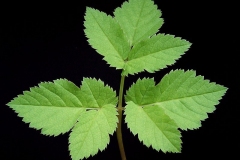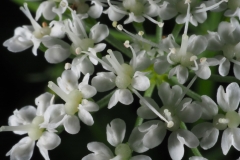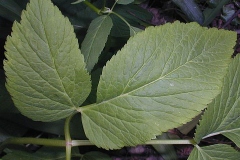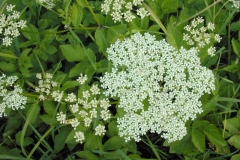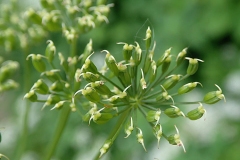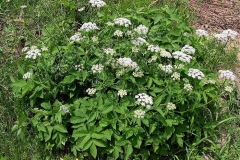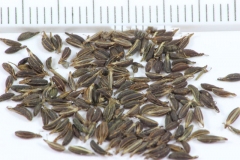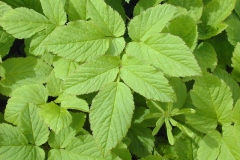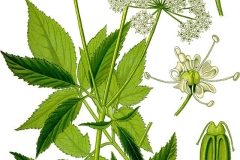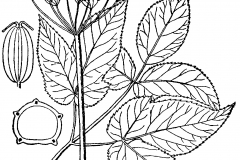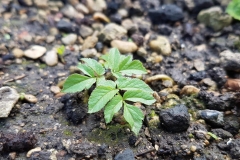| Goutweed Quick Facts | |
|---|---|
| Name: | Goutweed |
| Scientific Name: | Aegopodium podagraria |
| Origin | Europe, Asia Minor, and Central Asia |
| Shapes | Ovoid-oblongoid fruits that are ridged and somewhat flattened |
| Taste | Pungent |
| Health benefits | Good for rheumatism, arthritis, disorders of the bladder and intestines, burns, stings, wounds, painful joints, gouty and sciatic pains and hemorrhoids |
| Name | Goutweed |
|---|---|
| Scientific Name | Aegopodium podagraria |
| Native | Europe, Asia Minor, and Central Asia, but its native range is unclear. It has been introduced to North America, Australia, New Zealand, and Japan as an ornamental |
| Common Names | Ground Elder, Bishop’s goutweed, Goutweed, Ground Elder, Bishop’s Weed, Jack-jump-about, Herb Gerard, Ashweed, Achweed, English Masterwort, Wild Masterwort, Pigweed, Eltroot, Bishop’s Elder, Weyl Ash, White Ash, Bishopswort, Ground Ash, gout wort, snow-in-the-mountain |
| Name in Other Languages | Afrikaans: Goutweed Albanian: Goutweed, bar shtergjia, egopodë, këmbëdhia Amharic: Goutweed-ˈɡoutwēd Arabic: Altayib (الطيب), rajul aleunzat albistania (رجل العنزة البستانية) Armenian: Arshavank (արշավանք) Azerbaijani: Goutweed Bengali: Goutweed-ˈgoutˌwēd Bulgarian: Goutweed-ˈgoutˌwēd, blag bŭz (благ бъз), sedmolist (седмолист) Burmese: Kwmhkyaankone (ကွမ်းခြံကုန်း) Catalan: Podagraria Chinese: Gǔ tè wēi dé (古特威德) Chuvash: Серте Croatian: Goutweed, Podagrasti jarčevac Czech: Dna, bršlice kozí noha Danish: Skvalderkål, Gul Okseøje Dutch: Jicht, Zevenblad English: Goutweed, Ground-elder, Ashweed, Bishop’s goutweed, Bishop’s-weed, Herb-Gerard, ashweed Esperanto: Goutweed, Egopodio Estonian: Podagra, Harilik naat Filipino: Goutweed Finnish: Goutweed, Keltapäivänkakkara, Vuohenputki French: Goutweed, Herbe aux goutteux, Podagraire, Egopode, Égopode Podagraire, L’Égopode Podagraire, herbe de Saint Gérard, pied de chèvre, lehtovuohenputki, boucage à feuilles d’angélique, fausse angélique, petite angélique, pied d’aigle, pied de bouc Georgian: Goutweed-ˈgoutˌwēd German: Gichtkraut, Geißfuß, Giersch, Gewöhnlicher Giersch, Baumtropfen, Geissfuss, Dreifuß, Erdholder, Gichtgeißfuß, Hinfuß, Hinlauf, Podagrakraut, Zipperleinkraut Greek: Nkouts (γκουτς), Aigopódio to podágrio (Αιγοπόδιο το ποδάγριο) Gujarati: Goutweed, goutˌwēd Hausa: Goutweed Hebrew: Gaut (גאוט) Hindi: Goutweed-ˈgoutˌwēd Hungarian: Goutweed, Podagrafű Icelandic: Pvagsýrugigt, Geitakál Indonesian: Goutweed Irish: Goutweed, Lus an easpaig, lus an dá phingin Italian: Goutweed, Castalda, Girardina Silvestre, castaldina, egopodo, erba gerarda, pie di capra, podagraria, girardina silvestre Japanese: Hakobe (ハコベ), , iwamitsuno (イワミツバ) Javanese: Dikandhani Kannada: Gauṭvīḍ (ಗೌಟ್ವೀಡ್) Kazakh: Goutweed, Kädimgi snıtʹ, Кәдімгі сныть, كادىمگى سنىت Korean: Tongpung (통풍), san mi na ri (산미나리) Kurdish: Goutweed Lao: Goutweed-ˈgoutˌwēd Latin: Goutweed Latvian: Podagra, Podagras gārsa Lithuanian: Podagra, Paprastoji garšva Macedonian: Giht (гихт), obipen sedmolist (обипен седмолист) Malagasy: Goutweed Malay: Goutweed Malayalam: Sandhivātaṁ (സന്ധിവാതം) Maltese: Gotta marigold marsh pokeweed Marathi: Goutweed-ˈgoutˌwēd Mongolian: Goutweed-ˈgoutˌwēd Nepali: Goutweed-ˈɡoutwēd Netherlands: Zevenblad Northern Sami: Jiektabohcci Norwegian: Goutweed, Greinknoppurt, Gullkrage, Parykk-knoppurt, Skvallerkål Oriya: Goutweed Pashto: د ګیټ وید Persian: Goutweed, علف پابزی Picard: Flanèle Polish: Podagrycznik, podagrycznik pospolity, podagrycznik rzeczpospolity Portuguese: Goutweed, sabugueiro-anão Punjabi : Goutweed-ˈɡoutwēd Romanian: Goutweed, piciorul-caprei Russian: Snyt (сныть), Snyt’ obyknovennaya (Сныть обыкновенная) Scots: Beeshop’s weed Serbian: Goutveed (гоутвеед), obični sedmolist (обични седмолист) Sindhi: Goutweed Sinhala: Raktavātaya (රක්තවාතය) Slovak: Kozonoha hostcová, kozia noha hostcová, kozonohacová Slovenian: Goutweed, navadna regačica Spanish: Goutweed, egopodio, hierba de San Gerardo, aegopodio, Sudanese: Goutweed Swedish: Goutweed, Gul kamklint, Gullkrage, Sandklint, Svartklint, Kirskål, Vuohenputki, Ängsklint, Kers, Skvallerkål Tajik: Goutweed-ˈɡoutwēd Tamil: Kīlvātam (கீல்வாதம்) Telugu: Goutweed-ˈɡoutwēd Thai: Goutweed-ˈɡoutwēd Turkish: Goutweed, keçi ayağı Ukrainian: Podahrychnyy (подагричний), Yahlytsya zvychayna (Яглиця звичайна) Urdu: گاؤٹویڈ Uzbek: Goutweed Vietnamese: Goutweed Welsh: Goutweed, Llysiau`r gymalwst Zulu: Goutweed |
| Plant Growth Habit | Creeping, herbaceous perennial |
| Growing Climates | Hedgerows, cultivated land, grasslands, forests, gardens, logged areas, abandoned fields, pastures, roadsides, disturbed areas, woodland edges, churchyards, parks, flower beds, graveyards, shaded ravines, cemeteries and waste areas |
| Soil | Easily grown in average, dry to medium, well-drained soils in sun or shade |
| Plant Size | Grows from 4 to 12 inches (10-30 cm) tall [15], but it may grow to as tall as about 3 feet (1 m) |
| Root | Extensive root system that includes a main root and lateral roots |
| Stem | Short, hollow, with longitudinal grooves and rims, glabrous or covered with short-branched hairs. It contain only one set of leaves until the flower stem appears |
| Leaf | Large leaves are alternate, the lobes ovate and sharply-toothed, 2 to 3 inches long. The radical leaves are on long stalks, bi- and tri-ternate. There are fewer stem-leaves; they are less divided, with smaller segments. |
| Flowering season | July to August |
| Flower | Flowers are about 1/8 inches (3 mm.) across, consisting of 5 white petals with incurved tips and an inferior ovary with a pair of styles |
| Fruit Shape & Size | Ovoid-oblongoid fruits that are ridged and somewhat flattened. They are about 0.12-0.16 in. (3-4 mm) long and release their seeds at maturity during the autumn |
| Seed | Small and slightly lengthened about 3 to 4 mm long, similar in size and shape to carrot seeds, and ripen in late summer |
| Propagation | By seed or rhizomes |
| Flavor/Aroma | Mild aroma similar to the parsley or lemon |
| Taste | Pungent |
| Plant Parts Used | Herb, root, leaves |
Plant Description
Goutweed is a creeping, herbaceous perennial plant that normally grows from 4 to 12 inches (10-30 cm) tall, but it may grow to as tall as about 3 feet (1 m). The plant is found growing in hedgerows, cultivated land, grasslands, forests, gardens, logged areas, abandoned fields, pastures, roadsides, disturbed areas, woodland edges, churchyards, parks, flower beds, graveyards, shaded ravines, cemeteries and waste areas. The plant is easily grown in average, dry to medium, well-drained soils in sun or shade. The plant has extensive root system that includes a main root and lateral roots. Stem is short, hollow, with longitudinal grooves and rims, glabrous or covered with short-branched hairs. It contain only one set of leaves until the flower stem appears.
Leaves
Stalks are light green and glabrous. The basal and lower leaves are bipinnate with 6-9 leaflets, while the upper leaves are pinnate with 3 leaflets. When the leaves are bipinnate, they are ternately divided into 3 groups of leaflets (2 lateral groups & a terminal group); each group has 2-3 leaflets. The leaflets of basal and lower leaves are 2-3 inches long and 1¼-2 inches across. They are medium to dark green, more or less ovate in shape, serrate or doubly serrate along their margins, and hairless or nearly so. Some leaflets may be deeply cleft into two lobes. The leaflets of upper leaves are smaller in size and narrower in shape (lanceolate or oblong-lanceolate); otherwise they are similar to the leaflets of the preceding leaves. The petioles of basal and lower leaves are 4-12 inches long, while the petioles of upper leaves are less than 4 inches long. These petioles are light green and hairless. The petioles of alternate leaves are sheathed at their bases. The petiolule of the terminal group of leaflets is 2-3 inches long, while the petiolules of the lateral groups of leaflets are about 1 inch long. In each group of leaflets, the lateral leaflets are sessile or nearly so, while the terminal leaflet has a secondary basal stalklet that is nearly sessile to 1 inch long.
Flower
The stalks terminate in compound umbels of flowers about 1½-3½ inches across that are flat-topped. Each compound umbel is divided into 10-20 umbellets, while each umbellet is divided into 10-25 flowers. The compound umbels lack floral bracts and the umbellets lack floral bractlets. Individual flowers are about 1/8 inches (3 mm.) across, consisting of 5 white petals with incurved tips and an inferior ovary with a pair of styles. The peduncles of the compound umbels are 3-6 inches long, light green, glabrous, angular, and grooved. The pedicels of individual flowers are about ¼ inches in length, light green, and glabrous. The blooming period occurs from late spring to mid-summer, lasting about 1 month.
Fruit
The flowers are replaced by ovoid-oblongoid fruits that are ridged and somewhat flattened. They are about 0.12-0.16 in. (3-4 mm) long and release their seeds at maturity during the autumn. Seeds are small and slightly lengthened about 3 to 4 mm long, similar in size and shape to carrot seeds, and ripen in late summer.
Health Benefits of Goutweed
Goutweed has been used for curing numerous diseases in humans and animals, and it is used in Ayurvedic and Unani medical systems. Ayurvedic use of Goutweed includes treatment of atrophy, cachexia, spasms, and rheumatism.
1. Prevents Infective Diseases
Patients identified with fever and lung ailments, including bronchitis, the common cold, cough, consumption, and emphysema have also benefited from treatment with Goutweed.
2. Prevent Breathing problem
One should apply a paste of crushed fruit to treat asthma to the chest. The paste is also used for colic. In the Unani system, Bishop’s weed is used to enhance the body’s immune system.
3. Cures problem related to stomach
This may help treat several GI disorders, including diarrhea, gastritis, atonic dyspepsia, cholera, flatulence, and indigestion.
4. To treat diseases related to skin
The plant consists of methoxsalen, a compound used in the treatment of such skin conditions as psoriasis, tinea versicolor, and vitiligo. Methoxsalen is classified as a psoralen, a type of compound that increases the skin’s sensitivity to ultraviolet light. When taken orally or applied directly to the skin, methoxsalen is known to alter skin cells in a way that promotes the production of melanin or a natural substance that gives color to the skin to response to ultraviolet light exposure.
Traditional uses and benefits of Goutweed
- Ground Elder has a long history of medicinal use and was cultivated as a food crop and medicinal herb in the Middle Ages.
- Plant was used mainly as a food that could counteract gout, one of the effects of the rich foods eaten by monks, bishops etc. at this time.
- The plant is little used in modern herbalism.
- All parts of the plant are anti-rheumatic, diuretic, sedative and vulnerary.
- An infusion is used in the treatment of rheumatism, arthritis and disorders of the bladder and intestines.
- Externally, it is used as a poultice on burns, stings, wounds, painful joints etc.
- Plant is harvested when it is in flower in late spring to mid-summer and can be used fresh or be dried for later use.
- Homeopathic remedy is made from the flowering plant.
- It is used internally for aches in the joints, gouty and sciatic pains, and externally as a fomentation for inflamed parts.
- Roots and leaves boiled together, applied to the hip, and occasionally renewed, have a wonderful effect in some cases of sciatica.
- It also had a history as a medicinal herb to treat gout and arthritis, applied in hot wraps externally upon boiling both leaves and roots together.
- Ingested, the leaves have a diuretic effect and act as a mild sedative.
- This herb has been used to treat kidney, intestinal and bladder disorders, but more research still needs to be done.
- When used externally as a thick paste, goutweed can help heal gout, painful joints, sciatica, arthritis, hemorrhoids, wounds, burns and insect bites.
- Tea from dried leaves is a medicine recommended for the treatment of gout, hemorrhoids, inflammatory states of kidneys and bladder, auxiliary in nephrolithiasis and to improve metabolism.
- Fresh leaves administered on a wound facilitated quicker healing.
- It was used in the treatment of pains and sores in the past.
- Also for treating wounds or burns, a poultice of its leaves are applied.
- In the past by boiling the roots and leaves of the plant together, hot wraps were used for treating pains in bone-joints.
- The leaves can be used as well for mild sedative effects.
Culinary Uses
- Leaves can be consumed raw or cooked.
- The leaves are best harvested before the plant comes into flower, they can be used in salads, soups, or cooked as a vegetable.
- Tender leaves have been used in antiquity and throughout the Middle Ages as a spring leaf vegetable, much as spinach was used.
- It is commonly used for soup.
- Young leaves are preferred as a pot herb.
- Before flowers bloom, young leaves are plucked and used in the making of Goutweed soup with vegetables and onions.
- It can be made into a filling for empanadas.
- Fresh leafy greens can be made into delicious vegetarian dishes apart from salads.
- Young translucent leaves are best for salads and the slightly older leaves can be cooked like spinach.
- It can be used in salads, omelets, pesto, pizza, savory pies etc.
- Ground elder is particularly suitable in foods with basil, goat cheese and halloumi.
Other Different Uses
-
Used in Spice
It has been used as a spice and as a preservative. It is used as a commercial product in the food and flavoring industries. The fruits are used to flavor curries, pickles, biscuits, confections, and beverages. The fruit has stimulant, antispasmodic, and carminative properties.
-
For Cosmetic Uses
The plant has been made into solutions, ointments, lotions, powders, and deodorants. The plant is used in soaps and perfumes and has several applications in aromatherapy dating to ancient times. It is also used as a mouthwash, gargle, or toothpaste preparation in dentistry. Bishop’s weed has been used as an insecticide and anthelmintic.
Other Facts
- This species makes a good ground-cover for semi-wild situations.
- Since the leaves contain essential oils, they were previously used for wrapping vegetables for keeping them fresh.
- They can be effective in controlling soil erosion.
- It can be of immense use in gardens providing ground cover, growing below trees and shrubs.
- Leaves of this plant can be useful for grey dagger, dot moth and other Lepidoptera species to lay eggs, which later becomes the foraging plant.
- Not only European monks, Tibetan as well as Chinese monks too used this plant to heal physical ailments.
Precautions
- There’s some concern that bishop’s weed may trigger such side effects as headache, nausea, and vomiting.
- Since bishop’s weed changes the way your skin cells react to exposure to ultraviolet light, bishop’s weed may increase sensitivity to the sun and, in turn, raise your risk of skin cancer.
- Bishop’s weed may cause liver conditions to worsen, as well as inhibit blood clotting. People who are taking medications changed by the liver should use caution when taking the bishop’s weed.
- One should not use it with drugs that cause photosensitivity, including Elavil, (amitriptyline), Cipro (ciprofloxacin), Noroxin (norfloxacin), Maxaquin (lomefloxacin), Floxin (ofloxacin), Levaquin (levofloxacin), and tetracycline, among others.
- Avoid during pregnancy and it may also cause congenital defects.
Management Methods
Manual or Mechanical Control
Pulling / Digging Up
Hand pulling or digging young plants is effective, if time consuming. Care must be taken to remove all rhizomes, otherwise, re-sprouting will occur.
Mowing
Cutting at leaf out has been shown to decrease this species’ capacity for vegetative growth and spread. It is even more effective if performed repeatedly throughout the growing season in order to sap the plant’s starch reserves. Utmost care must be taken to complete control before the formation of fruit so as not to spread any viable seeds.
Soil Tilling
Tilling is not a recommended method of control as goutweed often colonizes fragile, moist soils vulnerable to erosion and will re-sprout from root fragments.
Mulching
Mulching can be a useful strategy in combination with other methods of management for small populations, such as hand pulling or cutting.
Chemical Control
The pesticide application rates and usage herein are recommendations based on research and interviews with land managers. When considering the use of pesticides, it is your responsibility to fully understand the laws, regulations and best practices required to apply pesticides in a responsible manner. At times, the pest you seek to treat may not be on a pesticide label, requiring a 2ee exemption from NYSDEC. Always thoroughly read the label of any pesticide and consult the NYSDEC or a licensed pesticide applicator with questions.
Foliar Spray
A 2-10% solution of glyphosate will brown goutweed’s leaves but not kill the entire plant. Repeat application will be necessary in several weeks. Always read and follow all instructions on the herbicide label.
References:
https://www.itis.gov/servlet/SingleRpt/SingleRpt?search_topic=TSN&search_value=29567#null
https://pfaf.org/User/plant.aspx?LatinName=Aegopodium+podagraria
https://www.botanical.com/botanical/mgmh/g/goutwe32.html
https://accs.uaa.alaska.edu/wp-content/uploads/Aegopodium_podagraria_BIO_AEPO.pdf
https://www.discoverlife.org/mp/20q?search=Aegopodium+podagraria&flags=col1:&res=640
https://www.cabi.org/isc/datasheet/3350
https://npgsweb.ars-grin.gov/gringlobal/taxon/taxonomydetail?id=102037
https://www.wikidata.org/wiki/Q217778
https://en.wikipedia.org/wiki/Aegopodium_podagraria
http://www.theplantlist.org/tpl/record/kew-2623499
https://www.fs.fed.us/database/feis/plants/forb/aegpod/all.html
https://www.invasive.org/browse/subinfo.cfm?sub=11534
http://www.plantsoftheworldonline.org/taxon/urn:lsid:ipni.org:names:5849-2
https://plants.usda.gov/core/profile?symbol=AEPO
https://www.nps.gov/orgs/1103/upload/FactSheet_BishopsGoutweed.pdf
https://gd.eppo.int/taxon/AEOPO
http://temperate.theferns.info/plant/Aegopodium+podagraria



